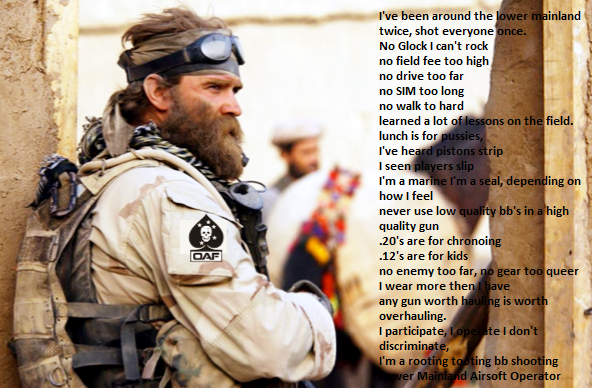![]() 2013-11-05 / 19:06 UTC GMT +00:00
2013-11-05 / 19:06 UTC GMT +00:00
Airsoft batteries.
I’m going to try and explain airsoft batteries to the best of my abilities. There is a lot to cover to excuse me if I miss something (If I do please add it to this thread). First thing I would like to address is the use of a smart charger. In the long run I believe it will save you money by prolonging the life of your batteries and reduce the risk of an electrical fire due to poor charging habits. Most smart chargers will charge damn near every Airsoft/RC battery available.
Airsoft batteries come in many shapes, sizes, amperages/output ratings and voltages. I constantly tell new players to figure out what they want out of their Airsoft gun, upgrade it and use the correct battery to get you to the performance you had in mind. Higher voltages and higher discharge rates will increase the rate of fire of your AEG as well as give you faster trigger response (the time it takes from the pull of the trigger to the shot taking place). Increasing the ROF will put more stress on all the internal components of your gearbox and can cause premature failure in mechanical parts.
Most common batteries include.
7.2v (usually AEP’s(automatic electric pistol))
8.4v NIMH or NICD (7 cells 1.2volts each= 8.4volts)
9.6v NIMH or NICD (8 cells 1.2volts each =9.6 volts)
7.4v LIPO (2 cells 3.7volts each= 7.4volts)
11.1v LIPO (3 cells 3.7volts each = 11.1volts)
All batteries have a MAH rating or milliampere hour rating. This dictates how long your battery will last. Higher MAH batteries are usually larger in size compared to smaller MAH rated batteries.
Example 9.6v 1600mah will last longer than a 9.6v 1000mah battery. (Assuming the discharge rate is the same)
Nickel–cadmium or NICD batteries:

These batteries like to be fully discharged after use. Not discharging them can damage the cell and create a memory effect (battery will not charge to 100%). These batteries are usually included with some AEG packages and do OK in terms of rate of fire and cold weather gaming.
Nickel–metal hydride battery. NIMH:

These batteries like to be stored at roughly 40% charge and can be damaged if they are fully discharged. I found that this chemistry of battery is more stable in cold weather conditions than NICD batteries and hold their charge longer. 20+bps at 400FPS can be achieved with a 9.6v 1600MAH battery so this battery is no joke. Before switching over to LiPo batteries I used a 9.6v 1600MAH NIMH battery for a whole year. That battery would last me an entire game day and would still have 30% charge left after I was done.
Lithium polymer battery, LiPo:


LiPo batteries are a great power source for the performance enthusiast. These batteries give you the ability to have a larger voltage, higher amperage output in a smaller tighter package as compared to the other types of batteries previously mentioned. These batteries are much more temperature stable and do not have a memory effect when charging. There are many things to consider before you go out and purchase a LiPo battery.
Voltage and C rating.
When it comes to Airsoft the most common voltage in LiPo batteries are 7.4v (2 cell) and 11.1v (3 cell). C rating and amperage output is where LiPo batteries are way ahead in terms of performance over your standard NICD or NIMH battery.
C rating correlates to the maximum amperage output rating of that particular battery. When a battery has for example 15-25c rating the first number indicates the minimum amperage output and the second number indicates the maximum burst amperage output for that battery .
The formula looks like this.
7.4v 2200Mah battery 15-30c rating.
2200x30=66,000 or 66AMPS max discharge rate from that battery.
Or
11.1v 1200Mah 12-20c rating.
1200x20=24,000 or 24 AMPS max discharge from the battery.
The electrical system in your AEG can be relatively complex. It is best to know the amperage needed to run your AEG to its full potential and match a battery accordingly. This can be really complicated since you need a voltmeter and were not going to get into that right now.
It is important to remember that your electrical system requires a LiPo battery that can supply it with enough amperage to run at its peak efficiency. The amperage coming out of your battery into your motor is not a push of energy out of the battery but a pull from the motor. That being said your motor will only PULL as much amps from your battery as needed for it to run at its maximum efficiency. Matching a LiPo battery with a max discharge of let’s say 20 amps with a motor that requires 35 amps is not a good idea. You will be starving your motor of power and you can cause LiPo battery to balloon or even catch fire.
For example, if your battery has a max continuous amperage output rating of 60 amps and your motor only needs 43amps to run efficiently, it’s only going to pull 43amps from your battery pack and no more.
High discharge rates and trigger switches.
High C rating batteries will cause premature trigger wear by electrical arcing. With high discharge batteries each time the trigger is pulled a small electrical arch is created from your switch which will slowly start to build up carbon and eventually render your switch useless. It is my opinion to find a LiPo battery that supplies your AEG with just enough power and nothing more.
The discharge rate on all my batteries are 15-25c Plenty of amps to power my AEG setups and not TOO powerful that they are going to damage my trigger contacts too much.
Charging and discharging LiPo batteries.
I bit off more than I can chew on this thread, my hand hurts and I don’t want to type anymore. This is a good read up on charging lipo cells and discharging lipo cells.
http://www.rcgroups.com/forums/showthread.php?t=209187
if i forgot anything please post away.
cheers
G
I’m going to try and explain airsoft batteries to the best of my abilities. There is a lot to cover to excuse me if I miss something (If I do please add it to this thread). First thing I would like to address is the use of a smart charger. In the long run I believe it will save you money by prolonging the life of your batteries and reduce the risk of an electrical fire due to poor charging habits. Most smart chargers will charge damn near every Airsoft/RC battery available.
Airsoft batteries come in many shapes, sizes, amperages/output ratings and voltages. I constantly tell new players to figure out what they want out of their Airsoft gun, upgrade it and use the correct battery to get you to the performance you had in mind. Higher voltages and higher discharge rates will increase the rate of fire of your AEG as well as give you faster trigger response (the time it takes from the pull of the trigger to the shot taking place). Increasing the ROF will put more stress on all the internal components of your gearbox and can cause premature failure in mechanical parts.
Most common batteries include.
7.2v (usually AEP’s(automatic electric pistol))
8.4v NIMH or NICD (7 cells 1.2volts each= 8.4volts)
9.6v NIMH or NICD (8 cells 1.2volts each =9.6 volts)
7.4v LIPO (2 cells 3.7volts each= 7.4volts)
11.1v LIPO (3 cells 3.7volts each = 11.1volts)
All batteries have a MAH rating or milliampere hour rating. This dictates how long your battery will last. Higher MAH batteries are usually larger in size compared to smaller MAH rated batteries.
Example 9.6v 1600mah will last longer than a 9.6v 1000mah battery. (Assuming the discharge rate is the same)
Nickel–cadmium or NICD batteries:

These batteries like to be fully discharged after use. Not discharging them can damage the cell and create a memory effect (battery will not charge to 100%). These batteries are usually included with some AEG packages and do OK in terms of rate of fire and cold weather gaming.
Nickel–metal hydride battery. NIMH:

These batteries like to be stored at roughly 40% charge and can be damaged if they are fully discharged. I found that this chemistry of battery is more stable in cold weather conditions than NICD batteries and hold their charge longer. 20+bps at 400FPS can be achieved with a 9.6v 1600MAH battery so this battery is no joke. Before switching over to LiPo batteries I used a 9.6v 1600MAH NIMH battery for a whole year. That battery would last me an entire game day and would still have 30% charge left after I was done.
Lithium polymer battery, LiPo:


LiPo batteries are a great power source for the performance enthusiast. These batteries give you the ability to have a larger voltage, higher amperage output in a smaller tighter package as compared to the other types of batteries previously mentioned. These batteries are much more temperature stable and do not have a memory effect when charging. There are many things to consider before you go out and purchase a LiPo battery.
Voltage and C rating.
When it comes to Airsoft the most common voltage in LiPo batteries are 7.4v (2 cell) and 11.1v (3 cell). C rating and amperage output is where LiPo batteries are way ahead in terms of performance over your standard NICD or NIMH battery.
C rating correlates to the maximum amperage output rating of that particular battery. When a battery has for example 15-25c rating the first number indicates the minimum amperage output and the second number indicates the maximum burst amperage output for that battery .
The formula looks like this.
7.4v 2200Mah battery 15-30c rating.
2200x30=66,000 or 66AMPS max discharge rate from that battery.
Or
11.1v 1200Mah 12-20c rating.
1200x20=24,000 or 24 AMPS max discharge from the battery.
The electrical system in your AEG can be relatively complex. It is best to know the amperage needed to run your AEG to its full potential and match a battery accordingly. This can be really complicated since you need a voltmeter and were not going to get into that right now.
It is important to remember that your electrical system requires a LiPo battery that can supply it with enough amperage to run at its peak efficiency. The amperage coming out of your battery into your motor is not a push of energy out of the battery but a pull from the motor. That being said your motor will only PULL as much amps from your battery as needed for it to run at its maximum efficiency. Matching a LiPo battery with a max discharge of let’s say 20 amps with a motor that requires 35 amps is not a good idea. You will be starving your motor of power and you can cause LiPo battery to balloon or even catch fire.
For example, if your battery has a max continuous amperage output rating of 60 amps and your motor only needs 43amps to run efficiently, it’s only going to pull 43amps from your battery pack and no more.
High discharge rates and trigger switches.
High C rating batteries will cause premature trigger wear by electrical arcing. With high discharge batteries each time the trigger is pulled a small electrical arch is created from your switch which will slowly start to build up carbon and eventually render your switch useless. It is my opinion to find a LiPo battery that supplies your AEG with just enough power and nothing more.
The discharge rate on all my batteries are 15-25c Plenty of amps to power my AEG setups and not TOO powerful that they are going to damage my trigger contacts too much.
Charging and discharging LiPo batteries.
I bit off more than I can chew on this thread, my hand hurts and I don’t want to type anymore. This is a good read up on charging lipo cells and discharging lipo cells.
http://www.rcgroups.com/forums/showthread.php?t=209187
if i forgot anything please post away.
cheers
G



